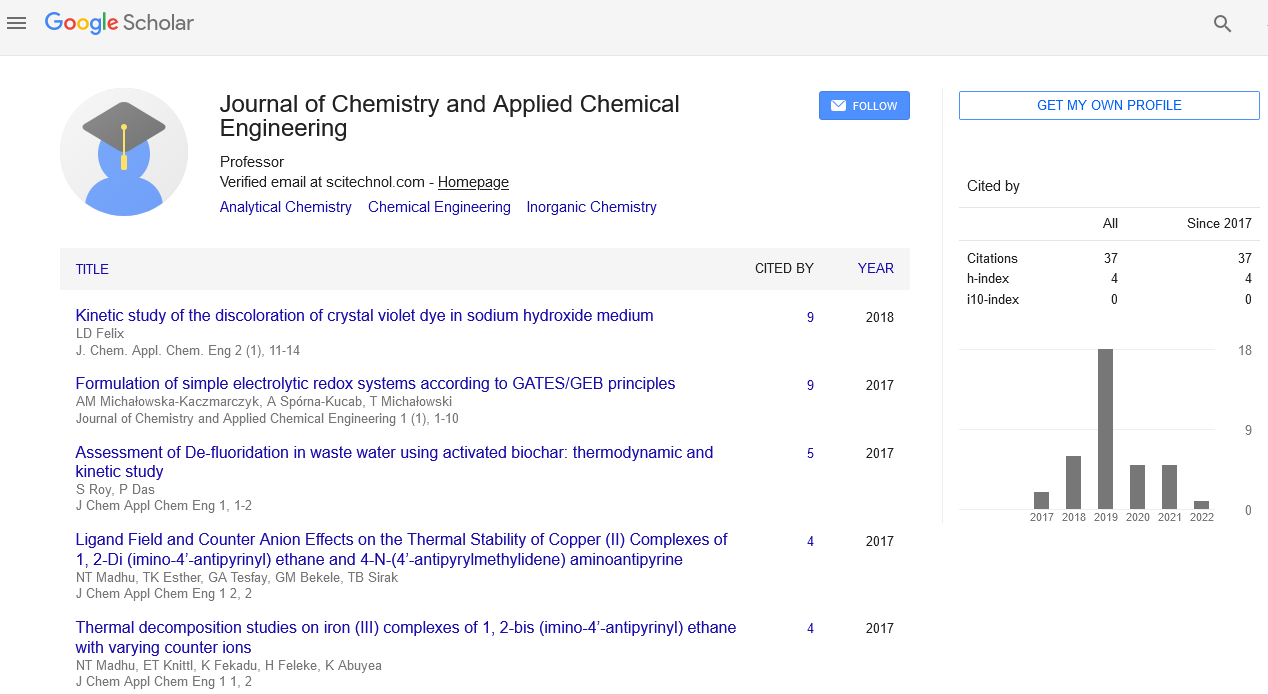Opinion Article, J Chem Appl Chem Eng Vol: 6 Issue: 1
Local Accumulation of Lymphocytes in the Intima of Human Aorta Is Associated with Giant Multinucleated Endothelial Cells
Dmitry V Zlenko
Department of Chemical Engineering, Istanbul Technical University, Maslak, Istanbul, Turkey
*Corresponding Author: Dr. Dmitry V Zlenko, Department of Chemical Engineering, Istanbul Technical University, Maslak, Istanbul, Turkey, E-mail: devrim.kaymak@itu.edu.tr
Received date: 03 January, 2022, Manuscript No. JCACE-22-55875;
Editor assigned date: 14 January, 2022, PreQC No. JCACE-22-55875 (PQ);
Reviewed date: 17 January, 2022, QC No. JCACE-22-55875;
Revised date: 19 January, 2022, Manuscript No. JCACE-22-55875 (R);
Published date: 27 January, 2022, DOI: 10.4172/Jcace.1000e003
Keywords: Analytical Chemistry, Astrochemistry, Atmospheric chemistry, Biochemical Engineering, Biological Chemistry, Chemical Engineering
Introduction
Distribution of different types of atherosclerotic lesions in the arterial wall isn't verbose, but is characterized by mosaicism. The causes of similar distribution remain to be established. At the early stages of atherogenesis, Low-Viscosity Lipoprotein (LDL) patches and vulnerable cells access into the intimal subcaste of the arterial wall through the endothelium. In adult humans, the luminal face of the arterial wall is a miscellaneous monolayer of cells with varying morphology including typical Endothelial Cells (ECs) and Multinucleated Variant Endothelial Cells (MVECs). We hypothecated that distribution of MVECs in the endothelial monolayer can be related to the distribution pattern of early atherosclerotic lesions. We attained en face medications of complete grown-up (22–59 times old) aortic wall sections that allowed us to study the endothelial monolayer and the subendothelial subcaste. We compared the distribution of MVECs in the endothelial monolayer with the localization of early atherosclerotic lesions in the subendothelial subcaste, which were characterized by lipid accumulation and vulnerable cell reclamation. In primary culture, MVECs demonstrated increased phagocytic exertion compared to mononuclear ECs. Also, we've shown that innocent aortic intima contained associates formed as a result of aggregation and/ or emulsion of LDL patches that arenon-randomly distributed. This indicated that MVECs may be involved in the accumulation of LDL in the subendothelial subcaste through increased transcytosis. Interaction of LDL with subendothelial cells of mortal aorta in primary culture increased their tenacious parcels toward circulating vulnerable cells. Study of innocent aortic intima revealednon-random distribution of leukocytes in the subendothelial subcaste and increased localization of CD45 leukocytes in the subendothelial subcaste conterminous to MVECs. Together, our compliances indicate that MVECs may be responsible for the distribution of atherosclerotic lesions in the arterial wall by sharing in LDL internalization and vulnerable cell reclamation.
Atherosclerosis is associated with lipid accumulation in the arterial wall, which is accompanied by the reclamation of seditious cells and increasedpro-inflammatory signaling. The main source of lipids is circulating low- viscosity lipoproteins (LDLs) piercing into the arterial wall, while the original seditious process is supported by the infiltration of circulating vulnerable cells. Some areas of the vascular system are more prone to atherosclerosis development than others. Specially, areas of disturbed laminar blood inflow similar as arterial bends and bifurcation points appear to be affected more constantly. Interestingly, indeed within atherosclerosis-prone areas, atherosclerotic lesions are distributed not exactly, but locally, and indeed focally in the arterial wall. The observed mosaic distribution of lesions at different stages of development remains to be explained. Moment, it remains unclear why some areas of the arterial wall are susceptible to lipid accumulation and habitual inflammation development, while other conterminous areas don't suffer similar changes.
Modified atherogenic LDL plays a special part in atherosclerosis development, since modified patches have altered uptake and declination patterns, causing massive intracellular lipid accumulation. LDL patches are also prone to tone- association, which further increases their atherogenic parcels, although the nature of similar LDL “associates” remains to be studied. Available studies indicate that reversible aggregation of LDL patches precedes their unrecoverable emulsion. It's clear that, in order to access into the arterial wall intima, both LDL patches and the vulnerable cells should bypass the monolayer of the endothelial cells (ECs) that separates the intima from the arterial lumen. The luminal face of the arterial wall of adult humans contains miscellaneous cells including typical ECs ( lower than 800 µm2) and giant Multinucleated Variant Endothelial Cells (MVECs) (up to 8000 µm2). The ultimate can be observed both in innocent intima and above the adipose stripes and pronounced atherosclerot.
 Spanish
Spanish  Chinese
Chinese  Russian
Russian  German
German  French
French  Japanese
Japanese  Portuguese
Portuguese  Hindi
Hindi 